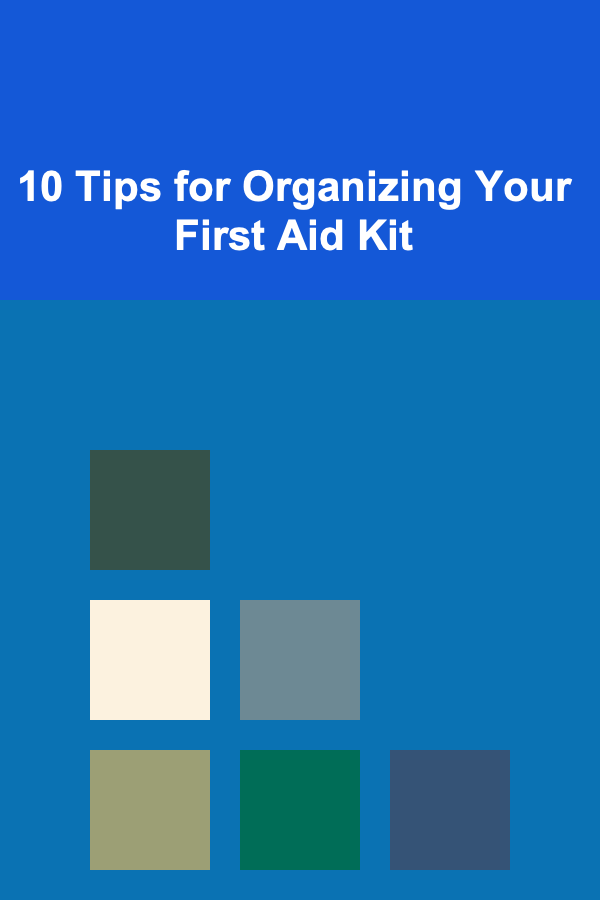
10 Tips for Organizing Your First Aid Kit
ebook include PDF & Audio bundle (Micro Guide)
$12.99$11.99
Limited Time Offer! Order within the next:

A first aid kit is an essential part of any home, car, or workplace. It's a small, portable collection of supplies that can be lifesaving in emergencies. However, it's easy to overlook the importance of keeping your first aid kit well-organized and fully stocked. An unorganized kit can lead to unnecessary stress in an emergency, and the items you need might be difficult to find when seconds count. Whether you're preparing a first aid kit for your home, car, or travels, ensuring it's well-organized can make a big difference in critical situations.
In this article, we'll cover 10 practical tips to help you organize your first aid kit effectively, ensuring that it's ready to be used whenever needed. These tips are designed to make your kit more efficient, accessible, and easier to maintain.
Choose the Right Container
The first step in organizing your first aid kit is selecting the right container. The container should be sturdy, waterproof, and easy to open quickly. It should also be large enough to hold all your essential supplies without being too bulky or cumbersome.
Key factors to consider:
- Size: Your container should fit your needs, whether it's for a small home kit, a travel kit, or a large workplace kit. Opt for a container that can hold multiple items without becoming overcrowded, but isn't so large that you can't easily find what you need.
- Material: Look for a container made of durable, waterproof material to protect your supplies from moisture. Plastic containers with snap-on lids are often ideal, but you can also find first aid bags with compartments designed for organizing supplies.
- Accessibility: Choose a container with multiple compartments or dividers to make it easier to organize and access your items. Transparent cases or bags allow you to see everything at a glance, saving you valuable time in an emergency.
By choosing the right container, you create a solid foundation for an organized and efficient first aid kit.
Categorize Your Supplies
When it comes to organizing a first aid kit, categorizing supplies is crucial. Grouping similar items together will help you find what you need quickly in an emergency situation. There are many different types of first aid supplies, so organizing them into categories can make the process much easier.
Common categories to consider:
- Wound care: Band-aids, gauze pads, adhesive tape, antiseptic wipes, and ointments.
- Pain relief and fever reduction: Painkillers like aspirin, ibuprofen, and acetaminophen.
- Burn care: Burn gel, cold compresses, and burn bandages.
- Allergic reactions: Antihistamines, epinephrine auto-injectors (if prescribed), and hydrocortisone cream.
- Medical tools: Tweezers, scissors, thermometers, and gloves.
- Emergency supplies: A first aid manual, emergency contact numbers, and a CPR face shield.
Grouping supplies by category ensures that you can quickly locate the necessary items when dealing with different types of injuries or medical emergencies.
Label Everything Clearly
One of the most important aspects of organizing your first aid kit is labeling the items clearly. Whether you're using a small pouch or a larger box, clear labeling will help you identify each item quickly and efficiently. In high-stress situations, time is of the essence, and spending extra seconds trying to decipher labels can delay necessary action.
Tips for labeling:
- Use clear, legible labels: Ensure the font is large enough to read and that the labels are printed on durable material that won't peel off easily.
- Color coding: If you have a variety of items, consider using color-coded labels or colored sections within your kit to differentiate categories. For instance, you could use red labels for wound care, blue for medications, and green for tools.
- Inventory list: Include a printed inventory list of the items in your kit, attached to the inside lid of the container or in a zippered pocket. This list should be updated regularly to reflect any changes or replacements in your first aid kit.
A well-labeled first aid kit reduces the time it takes to locate specific items in emergencies, which can make a big difference in how quickly you respond.
Keep Items in Their Original Packaging
When adding new items to your first aid kit, it's often best to keep them in their original packaging. The original packaging typically includes important information such as expiration dates, usage instructions, and safety warnings. This information is essential for ensuring the proper use of items, especially in urgent situations.
Benefits of keeping items in their original packaging:
- Clarity of use: Instructions and warnings are more easily accessible, reducing the chance of misuse.
- Expiration tracking: Many first aid supplies, such as medications or wound care items, have expiration dates. Original packaging usually features this information prominently.
- Compactness and protection: Original packaging is designed to protect items from damage or contamination, ensuring they stay sterile and effective.
Whenever possible, avoid taking items out of their original packaging unless necessary. If you must remove items, use resealable bags or containers that keep them protected.
Regularly Check for Expired or Damaged Items
One of the most important aspects of maintaining an organized first aid kit is regularly checking the contents for expired or damaged items. Just like any emergency kit, a first aid kit is only effective if its supplies are in good condition and usable.
What to check:
- Expiration dates: Medications, antiseptics, bandages, and many other items have expiration dates. Make it a habit to check these dates every six months and replace anything that's past its expiration.
- Packaging condition: Check that all packaging is intact and hasn't been compromised. For example, if bandages are torn or medications have been exposed to moisture, they may no longer be effective.
- Wear and tear: Items like scissors, tweezers, or thermometers can get worn out over time. Inspect these tools to ensure they're functioning properly.
Keeping your kit updated with fresh supplies ensures that you're always prepared for any emergency.
Include Specific Items Based on Your Needs
While every first aid kit should have basic supplies, there are specific items that may be necessary depending on your personal or family health needs. If you or anyone in your household has specific medical conditions or allergies, be sure to include the items required for those situations.
Examples of personalized items:
- Prescription medications: If anyone in your household takes daily medications, consider adding an extra supply to your first aid kit.
- Allergy medications: If you or a family member have known allergies, keep antihistamines or an epinephrine auto-injector (EpiPen) in your kit.
- Medical history documents: If you or someone in your household has a chronic condition, include a brief medical history with emergency contact information and any relevant medical instructions.
Customizing your first aid kit to suit your unique needs ensures that you have the right supplies when needed most.
Keep Small Items Organized with Pouches or Ziploc Bags
Smaller items, like individual band-aids, gauze pads, or medications, can easily get lost in a large first aid kit. To keep things organized, consider using small pouches or Ziploc bags to group similar items together. These bags help prevent small items from getting lost or damaged and make it easier to locate specific supplies quickly.
How to organize small items:
- Use clear pouches or bags: Clear plastic pouches or Ziploc bags make it easier to see the contents without opening them. You can label the bags for quick identification.
- Group similar items: Place similar items together, such as band-aids, gauze, and antiseptics in one pouch and medications in another. This will save time when you need to find something quickly.
Small pouches or bags are an excellent way to keep your first aid kit well-organized and easy to navigate.
Include a First Aid Manual or Emergency Guide
A well-organized first aid kit should also include a first aid manual or emergency guide. While you may not always have the luxury of having expert medical help available, a quick reference guide can provide you with step-by-step instructions on how to handle various medical emergencies.
Benefits of including a guide:
- Step-by-step instructions: Guides can provide critical instructions for performing CPR, handling fractures, treating burns, or managing other common injuries.
- Clear illustrations: Many first aid manuals include illustrations that make it easier to understand the steps required, even under stress.
- Peace of mind: Having a manual in your kit can give you confidence that you're taking the right steps in an emergency situation.
Be sure to choose a guide that's easy to follow and includes comprehensive instructions for a wide range of emergencies.
Consider Special Needs for Travel Kits
If you're assembling a first aid kit for travel, you'll need to consider additional items that may not be necessary in a stationary kit. Travel introduces unique risks, such as exposure to different environments, changes in diet, and potential travel-related illnesses.
Travel-specific items to consider:
- Motion sickness medication: If you're traveling by car, boat, or plane, consider adding medications for motion sickness.
- Insect repellent and bite relief: Travel often exposes you to new environments where insect bites may be common.
- Water purification tablets: If you're traveling to areas with uncertain water sources, it's wise to include water purification tablets or a portable water filter.
- Travel-specific conditions: If you're traveling abroad, consider including necessary vaccinations, specific medications, or items that cater to any pre-existing medical conditions.
Tailoring your first aid kit to suit the specifics of your travel plans ensures you're ready for any situation that may arise.
Store Your Kit in an Accessible Location
Lastly, storing your first aid kit in a location that's easily accessible is crucial for organization. A first aid kit that's difficult to reach will be of little use when you need it most. Make sure it's stored in a place that everyone in your household knows about and can access quickly.
Best storage locations:
- Home: Store your first aid kit in a common area like the kitchen, hallway, or bathroom. It should be easily reachable and well marked.
- Car: Keep your kit in your car's glove compartment or another easily accessible location.
- Workplace: In a workplace setting, place the first aid kit in a central, well-signposted location where employees can quickly locate it.
Easy access to your kit ensures you won't waste time searching for it during an emergency.
Conclusion
Organizing a first aid kit is not just about stuffing a box full of supplies; it's about creating a well-thought-out, efficient system that's ready for action when you need it most. By following these 10 tips, you can ensure that your first aid kit is organized, accessible, and equipped with everything necessary to handle a variety of medical emergencies. Regular checks, thoughtful customization, and smart storage will keep your first aid kit in top shape, giving you peace of mind in any situation.
Reading More From Our Other Websites
- [Home Budget 101] How to Manage a Variable Income: Budgeting Tips for Freelancers and Gig Workers
- [Home Party Planning 101] How to Host an Unforgettable New Year's Eve Party with Creative Ideas
- [Personal Investment 101] How to Evaluate Real Estate Markets for Investment Opportunities
- [Personal Finance Management 101] How to Invest in Stocks as a Beginner
- [Toy Making Tip 101] Showcase Your Creations: How to Share and Monetize Your Toy-Making Passion Online
- [Personal Finance Management 101] How to Automate Your Savings for Consistent Growth
- [Organization Tip 101] How to Organize Your Pet's Schedule and Supplies
- [Home Staging 101] How to Stage Outdoor Spaces to Create a Cozy, Inviting Atmosphere
- [Organization Tip 101] How to Use Drawer Dividers for Customized Storage
- [Home Holiday Decoration 101] How to Decorate Your Home with Natural Elements for a Rustic Holiday Look

How to Integrate Indoor and Outdoor Living During a Renovation
Read More
How to Make Money Online as a Physical Therapist Assistant? 10 Actionable Ideas
Read More
How to Prevent Fleas and Ticks in Your Home and Pet
Read More
The Environmental Engineer's Guide to Sustainable Solutions
Read More
Top Deep Learning Projects That Can Earn You Money
Read More
How to Master Frugal Living
Read MoreOther Products

How to Integrate Indoor and Outdoor Living During a Renovation
Read More
How to Make Money Online as a Physical Therapist Assistant? 10 Actionable Ideas
Read More
How to Prevent Fleas and Ticks in Your Home and Pet
Read More
The Environmental Engineer's Guide to Sustainable Solutions
Read More
Top Deep Learning Projects That Can Earn You Money
Read More